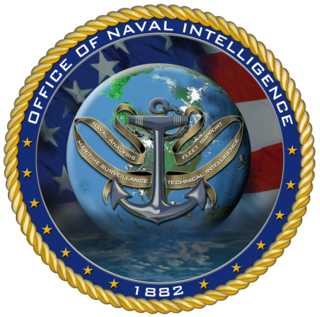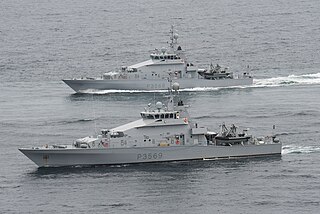
A coast guard or coastguard is a maritime security organization of a particular country. The term embraces wide range of responsibilities in different countries, from being a heavily armed military force with customs and security duties to being a volunteer organization tasked with search and rescue without law enforcement authority. In most countries, a typical coast guard's functions are distinct from those of the navy and the transit police, while in certain countries they have similarities to both.

USS Preble (DDG-88) is an Arleigh Burke-class destroyer in the United States Navy. She is the sixth U.S. Navy ship named in honor of Commodore Edward Preble, who served in the American Revolutionary War and was one of the early leaders of the Navy.
Fisheries and Oceans Canada is a department of the Government of Canada that is responsible for developing and implementing policies and programs in support of Canada's economic, ecological and scientific interests in oceans and inland waters. Its mandate includes responsibility for the conservation and sustainable use of Canada's fisheries resources while continuing to provide safe, effective and environmentally sound marine services that are responsive to the needs of Canadians in a global economy.

The Naval Service is the maritime component of the Defence Forces of Ireland and is one of the three branches of the Irish Defence Forces. Its base is in Haulbowline, County Cork.

LÉ Aisling, now known as Al-Karama, was a patrol vessel in the Irish Naval Service from 1980 to 2016. She was built in Verolme Dockyard, Cork, Ireland in 1979 and originally named after Patrick Pearse's poem, "Aisling" to commemorate the centenary of his birth. During her career, Aisling participated in the Sonia and Marita Ann incidents, and was one of the first ships to arrive on the scene of the Air India Flight 182 disaster, and subsequently participated in recovery operations. She was the adopted ship of Galway, and officially decommissioned in her adopted city in June 2016.

The Office of Naval Intelligence (ONI) is the military intelligence agency of the United States Navy. Established in 1882 primarily to advance the Navy's modernization efforts, it is the oldest member of the U.S. Intelligence Community and serves as the nation's premier source of maritime intelligence.

The Lake-class inshore patrol vessel is a ship class of inshore patrol vessels (IPVs) of the Royal New Zealand Navy (RNZN) which replaced the RNZN's Moa-class patrol boats in 2007–2008. All four vessels were originally named after New Zealand lakes. Two of the ships were sold to Ireland in 2022.

The Directorate of Military Intelligence is the military intelligence branch of the Defence Forces, the Irish armed forces, and the national intelligence service of Ireland. The organisation has responsibility for the safety and security of the Irish Defence Forces, its personnel, and supporting the national security of Ireland. The directorate operates domestic and foreign intelligence sections, providing intelligence to the Government of Ireland concerning threats to the security of the state and the national interest from internal and external sources.

The Nigerian Navy (NN) is the naval branch of the Nigerian armed forces. With more than 70 warships, it is categorised as the fourth strongest navy in Africa. It is considered well-trained and has participated in several peacekeeping missions.
The structure of the United States Navy consists of four main bodies: the Office of the Secretary of the Navy, the Office of the Chief of Naval Operations, the operating forces, and the Shore Establishment.
A Sector is a shore-based operational unit of the United States Coast Guard. Each Sector is responsible for the execution of all Coast Guard missions within its Area of Responsibility (AOR), with operational support from Coast Guard Cutters and Air Stations. Subordinate commands within a Sector typically include Stations and Aids-to-Navigation (ATON) Teams. Some Sector commands also have subordinate units such as Sector Field Offices and Marine Safety Units that are responsible for mission execution in parts of the Sector's AOR. There are 37 sectors within the Coast Guard.

The Operational Test and Evaluation Force (OPTEVFOR) is an independent and objective agency within the United States Navy for the operational testing and evaluation (OT&E) of naval aviation, surface warfare, submarine warfare, C4I, cryptologic, and space systems in support Navy and Department of Defense acquisition programs.
The Fleet Command is responsible for the command, operations, readiness, training and force generation of all ships, submarines, aircraft squadrons, diving teams, and shore establishments of the Royal Australian Navy. Fleet Command is headquartered at HMAS Kuttabul in Sydney, and is led by the Commander Australian Fleet (COMAUSFLT), also referred to as Fleet Commander Australia (FCAUST), which is a rear admiral (two-star) appointment.

The Navy Command is the current headquarters body of the Royal Navy, and as of 2012 its major organisational grouping. It is a hybrid, neither a command, nor simply an installation. Royal Navy official writings describe Navy Command Headquarters both as a physical site, on Whale Island, Hampshire, a collective formed of the most senior RN officers, and as a budgetary grouping.

The Admiral Benelux (ABNL) is the Commanding Officer of the combined military staff of the Royal Netherlands Navy and the Naval Component of the Belgian Armed Forces.

The U.S. Naval Forces, Vietnam was a command of the United States Navy, active during the Vietnam War, from 1 April 1966 to 29 March 1973.
Naval Support Command is one of three command components of the Irish Naval Service responsible for supporting all operations of the Naval Service, both on land and at sea. Headed by Officer Commanding Naval Support Command (OCNSC), who reports directly to the head of the Irish Naval Service, Flag Officer Commanding Naval Service (FOCNS) Commodore Hugh Tully, the Naval Support Command oversees the personnel, logistical and technical resources of the NS, allowing the service to meets its operational and training commitments. As part of NSC there are four departments within that provide various support services.
The Naval College is the principal naval military college in Ireland providing training to cadets, non-commissioned officers and recruits of the Irish Naval Service. The Naval College trains and educates personnel for service, providing a mixture of different courses ranging from officer training right through to naval engineering. The Naval College is based out of the Naval Service's headquarters at Naval Base Haulbowline but also provides classes and lessons in non-military naval training at the nearby National Maritime College of Ireland in Ringaskiddy.
This article represents the structure of the Irish Defence Forces as of May 2020:












